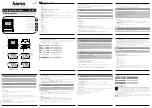
GB
22
2.1 Choosing the best place to install the detector
The detector must be placed:
• in rooms where there is a fire hazard (living rooms with fireplace, children’s
bedrooms, occupied lofts or basements, etc.) (
Fig. A
),
• preferably in the centre of the ceiling,
• far away from fan vents likely to spread smoke,
• more than 50 cm away from any obstacles (walls, partitions, beams, etc.) (
Fig. B
),
• at each end of corridors if they are longer than 10 m.
If the detector cannot be installed horizontally on the ceiling, fix it:
• at a distance of 40 to 50 cm from the ceiling (
Fig. B
),
• far away from any sources of electrical disturbance (electricity meter, metal cabinet,
electronic ballast, etc.).
The detector must not be placed:
• close to an electronic ballast, low voltage transformer, energy saving light bulbs,
fluorescent tubes, etc. (minimum distance: 50 cm),
• in excessively dusty rooms,
• in a room where the temperature might drop below -10°C or rise above +65°C,
which would prevent the detector from operating properly,
• at least 1 m away from heating, cooling or air circulation vents likely to disseminate
smoke,
• at least 6 m away from a fireplace or wood burning stove where the smoke from
combustion might trigger an unnecessary alarm,
• in an area where cooking fumes and water vapour might cause unwanted triggering,
• in a room where there might be condensation or damp (do not use in bathrooms,
laundries, etc.)
• at the centre of a pointed ceiling (A-shaped), as the air pocket located here can
prevent smoke from reaching the detector (
Fig. C
),
• directly on to a metal wall: use a non-magnetic spacer (wooden or plastic).
2. Installation
















































